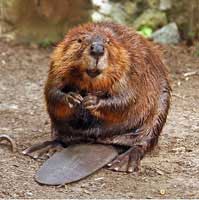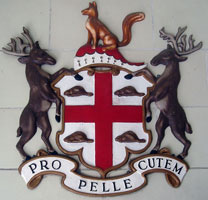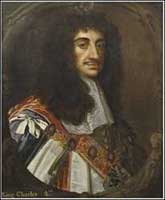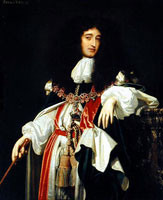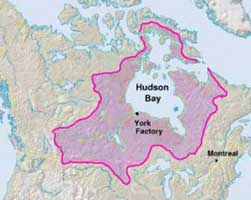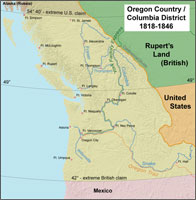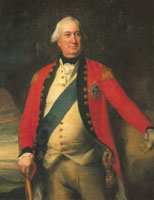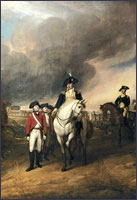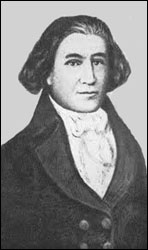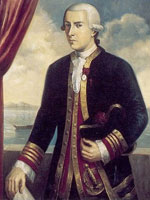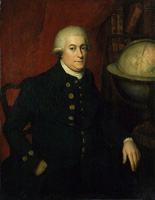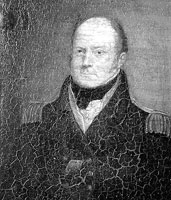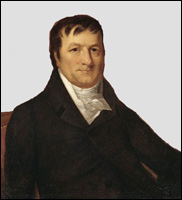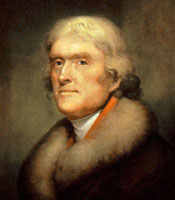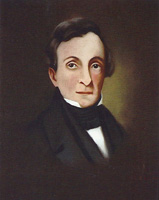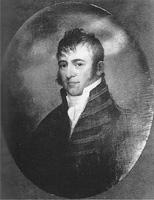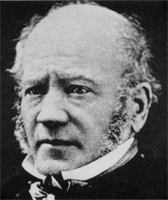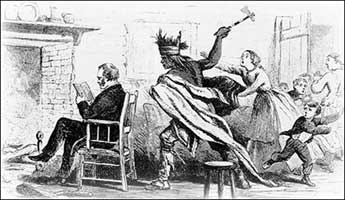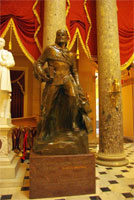SO SATAN ANSWERED JEHOVAH AND "SKIN FOR SKIN, YES, ALL
THAT A MAN HAS HE WILL GIVE FOR HIS LIFE (JOB 2:4). |
In the Book of Job, Lucifer challenged JEHOVAH and said that a man will give anything to save his life. In the case of the Hudson's Bay Company, they would give anything . . . even sell their own souls . . . for a BEAVER'S SKIN!!
The American and French Revolutions were financed by Spanish silver . . . and Hudson's
|
Canada was created by the Hudson's Bay Company and the HBC was indistinguishable from the British Empire. After the Union of Britain and Scotland in 1707, most of the HBC overlords and fur trappers were Scotsmen.
The French owned Northwest Fur Company was a bitter rival of the HBC until 1821. Then the two monopolies merged to block the expansion of the Tabernacle of David and keep the Gospel of Christ from the Indians.
In the British Empire, beaver skins were the equivalent of Spanish silver and gold. Beaver skin hats were in great demand in Britain and France.
|
The Governor and Company of Adventurers of England Trading into Hudson's Bay was incorporated on May 2, 1670, with a royal charter from King Charles II. The charter granted the company a monopoly over the region drained by all rivers and streams flowing into Hudson Bay in northern Canada. The area was called Rupert's Land after Prince Rupert, the first governor of the company appointed by the king. This region, the drainage basin of Hudson Bay, constitutes 1.5 million square miles, comprises over one-third the area of modern day Canada and stretches into the north central United States. The specific boundaries were unknown at the time. Rupert's Land would eventually be Canada's largest land purchase in the 1800s.
|
Their charter was almost a verbatim copy of the 1493 Bull of Borgia prohibiting all but Spaniards from visiting the New World:
Wee streightly Charge Command and prohibitt for us our heires and Successors all the subjectes of us our heires and Successors of what degree or Quality soever they bee that none of them directly or indirectly doe visit haunt frequent or Trade Trafficke or Adventure by way of Merchandize into or from any the said Territoryes Lymittes or Places hereby granted or any or either of them other then the said Governor and Company and such perticuler persons as now bee or hereafter shall bee of that Company theire Agentes Factors and Assignes unlesse itt bee by the Lycence and agreement of the said Governor and Company in writing first had and obteyned under theire Common Seale to bee granted upon paine that every such person or persons that shall Trade or Traffick into or from any the Countryes Territoryes or Lymittes aforesaid other then the said Governor and Company and theire Successors shall incurr our Indignacion and the forfeiture and the losse of the Goodes Merchandizes and other thinges whatsoever which soe shall bee brought into this Realme of England or any the Dominions of the same contrary to our said Prohibicion or the purport or true meaneing of these presentes for which the said Governor and Company shall finde take and seize in other places out of our Dominions where the said Company theire Agentes Factors or Ministers shall Trade Traffick inhabitt by vertue of these our Letters Patente As alsoe the Shipp and Shippes with the Furniture thereof wherein such goodes Merchandizes and other thinges shall bee brought or found the one halfe of all the said Forfeitures to bee to us our heires and successors and the other halfe thereof. (The Royal Charter for incorporating The Hudson's Bay Company, A.D. 1670.)
The only thing the charter omitted was damnation in hell for trespassing on "their" territory. This charter later led to the 7 Years' War or French and Indian War:
Then JEHOVAH said unto me, "out of the north an evil shall break forth upon all the inhabitants of the land" (Jeremiah 1:14).
By the time of the American Revolution, the main focus of the Company was on the West Coast because all the beavers were killed on the East Coast.
|
The East Coast was rocky and the only cash crop that grew there was tobacco. On the other hand, California was a literal gold mine and the climate in Oregon was perfect for growing all kinds of crops. The Hudson's Bay Company soon expected to extend their monopoly to the entire Gold Coast.
When the several states joined the Union, they all agreed to give up their western claims, as many of their original charters extended to the South Sea or Pacific Ocean.
During the Age of Discovery, and long afterward, if an explorer found the mouth of a river, all the land drained by that river belonged to his nation. The Hudson's Bay Company was most anxious to discover the mouth of the "Great River of the West" because they wanted to claim all of Oregon.
Captain Robert Gray won the race to discover the Columbia River!!
The race to discover the "Great River of the West" was won by an enterprising U.S. captain named Robert Gray. At that time, 3 countries were contenders in the race: Spain, the United States, and Britain a.k.a. the Hudson's Bay Company.
Even the renowned mariner Captain Cook sailed past the mouth of the river but dismissed it as a small bay or cove.
|
George Vancouver–a protégé of Captain Cook–was the best sailor the Hudson's Bay Company had on the Pacific Northwest . . . but he could not find the river. About 5 months after Captain Gray left for home, Vancouver visited the Commandant, who shared Gray's chart with him:
Five months to a day after Gray left the Columbia, Vancouver, having obtained copies of Gray's chart and narrative from Quadra, the Spanish Commander at Nootka Sound, sent his subordinate, Broughton, into the river, who, anchoring a few miles from the ocean, rowed 80 miles farther up the stream, and then had the effrontery "To take possession of the river and the country in its vicinity in His Britannic Majesty's name, having every reason to believe that the subjects of no other civilized nation or state had ever entered this river before. In this opinion he was confirmed by Gray's sketch, in which it does not appear that Mr. Gray either saw, or was within five leagues of its entrance." (Cf. Vol. 1, Chap. XL, and Vol. 2, Chap. III., of "A Voyage of Discovery to the No. Pacific Ocean and Round the world, etc., under command of Capt. George Vancouver, London, 1798."). (Marshall, Acquisition of Oregon, p. 38).
Like Christopher Columbus, it is very easy to be a "Discoverer" when you follow charts and maps. Vancouver sent his subordinate, Lieutenant William Robert Broughton, up the river to claim prior discovery.
|
The pompous Vancouver named everything in sight after himself and his crew. He was even contemplating naming the river after himself. He took the stolen chart back to London, where it lay hidden in the Public Record Office for 200 years:
For many years Gray's chart was believed lost, but Paul Rigdon, former curator of the Union Pacific Historical Museum, found the missing chart in an obscure file in the Public Record Office in London in 1961, where it apparently had been placed, and forgotten, along with records of George Vancouver's voyages. Rigdon said in his 1975 book on the subject: "Never in all the years of chosen avocation have I experienced such a profound thrill of satisfaction as this, the establishment of the ultimate title to the discovery of the Columbia River."(Nokes, Columbia's River, p. 194).
The whole history of the Hudson's Bay Company is full of similar fraud and deceit. Once established in Oregon, the Company needed an excuse to set up a military post at the mouth of the river. Their secret agent to accomplish their nefarious scheme was named John Jacob Astor.
Hudson's Bay Company spy John Jacob Astor!!
John Jacob Astor was the first of the long line of Hudson's Bay robber barons who would follow: Carnegie, Morgan, Rockefeller, Vanderbilt, etc., etc. Unlike fellow spies John Sutter and Albert Gallatin, he was German and not Swiss.
|
President Jefferson ordered another Hudson's Bay operative, Treasury Secretary Albert Gallatin, to give Astor all the assistance he needed in setting up his "trading post" on the Pacific coast.
|
When the tyrannical Thorn arrived on the Pacific Coast, he attempted to trade with the local Nootka people. Angered by what they considered insulting behavior, the Indians seized the Tonquin, and in a brief bloody action, killed Thorn and his crew. The next day, while the ship was being plundered by the Nootka, one of the crew members waited until the vessel was filled with Indians . . . and then blew it up.
The War of 1812 was a perfect excuse for the Hudson's Bay Company to seize Fort Astoria.
In December 1813, Captain William Black of the Hudson's Bay Company formally took possession of the fort and renamed it Fort George. After the British defeat at the Battle of New Orleans, the fort remained in the hands of the Hudson's Bay Company, and Oregon was declared a joint possession of the two countries.
The massacre of the Whitmans by the Hudson's Bay Company!!
The Hudson's Bay Company wiped out millions of Indians by spreading smallpox and cholera among the tribes. They also used biological warfare in a desperate attempt to halt the westward expansion of the Tabernacle of David. Only the Day of Judgment will reveal how many innocent people were killed by that Satanic organization.
|
In 1841, the ruthless Simpson was knighted by HBC marionette Queen Victoria. What the Hudson's Bay Company did to the Whitmans is just a microcosm of the diabolical career of that nefarious Jesuit controlled Company.
|
At a terrible cost in lives, the brave male and female pioneers saved California and Oregon from the Hudson's Bay Company. The Company wears a new mask today, but the same Satan or Lucifer, who inspired its creation in 1670, has not yet been banished to the Lake of Fire and Brimstone.
It's time for the United States to enforce the Monroe Doctrine and drive the British and their Hudson's Bay Company out of Canada for good. All the countries of the New World, except Canada, are Republics, and our Great JEHOVAH put 3,000 miles of water between Europe and the New World for a very, very good reason.
Vital links
References
Barrows, William. Oregon: The Struggle for Possession. Houghton, Mifflin and Company, Cambridge, MASS, 1884.
Bown, Stephen R. Madness, Betrayal and the Lash: The Epic Voyage of Captain George Vancouver. Douglas & McIntyre, Vancouver, Canada, 2008.
Dolan Eric Jay. Fur, Fortune, and Empire: the Epic History of the Fur Trade in America. W.W. Norton & Co., New York, 2010.
Dye, Eva Emery. McLoughlin and Old Oregon. Wilson-Erickson, Inc., New York, 1936.
Fitzgerald, James Edward. An Examination of the Charter and Proceedings of the of the Hudson's Bay Company. Trelawney Saunders, London, 1849.
Grey, William Henry. A History of Oregon, 1792–1848. Harris & Hollman, Portland, Oregon, 1870.
Marshall, William Isaac. Acquisition of Oregon. Lowman & Handford Co., Seattle, Washington, 1911.
Newman, Peter C. Empire of the Bay: The Company of Adventurers That Seized a Continent. Penguin Books, New York, 2000.
Nixon, Oliver, W. How Marcus Whitman Saved Oregon. Star Publishing Co., Chicago, 1895.
Nokes, Richard J. Columbia's River: The Voyages of Robert Gray, 1787–1793. Washington State Historical Society, 1991.
Rigdon Paul. Captain Robert Gray's Charts Discovered After Almost Two Centuries. Gonzaga University Press, Spokane, Washington, 1975.
Stark, Peter. Astoria: John Jacob Astor and Thomas Jefferson's Lost Pacific Empire. HarperCollins, New York, 2014.
Terrell, John Upton. Furs By Astor. William Morrow & Co., New York, 1963.
Copyright © 2014 by Patrick Scrivener
